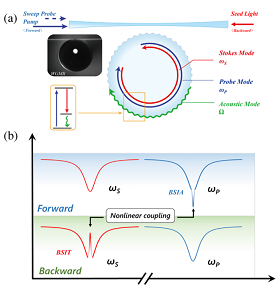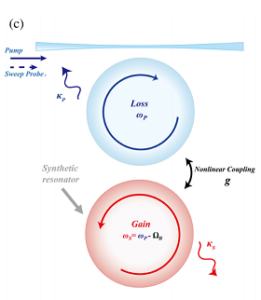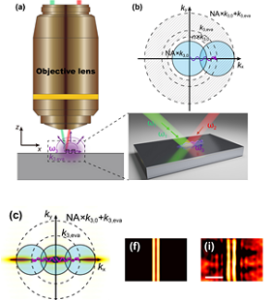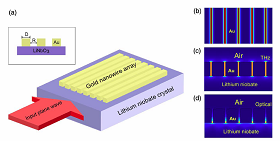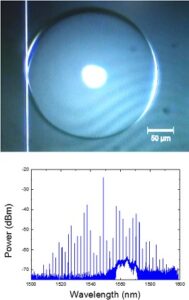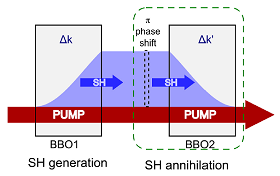Synthetic PT and anti-PT System
Since the foundation of quantum mechanics, its research scope has been limited to the Hermitian systems. It has been recognized for a long time that the Hermite system is a sufficient condition for obtaining observable physical quantities. However, many of the systems do not satisfy the Hermitian property because of the gain or loss characteristics, such as lasers, lossy waveguides and oscillators. Therefore, the study of non-Hermitian systems is of great significance, which can greatly expand the research field of quantum mechanics. However, most of the non-Hermitian systems are not suitable for quantum research. As we can’t find the eigenvalues of real numbers in these systems. Fortunately, there are also some special cases, two of which are PT system and anti PT system.
Previous studies on PT and anti PT systems are carried out in complex space coupled systems, which greatly increases the difficulty of research and limits their applications. In this work, we use synthetic dimension[1] to realize the research of non-Hermite system in a simpler and lower dimensional platform, that is, a single microcavity.
Using two different frequency optical modes in an optical microcavity instead of the existing spatial odd-even potential field, we synthesized an additional frequency domain by using Brillouin-enhanced nonlinearity in a four-wave mixing system, and then established an anti-PT symmetry system in the synthetic spectral dimension. The two non-linear coupling modes interact, resulting in Brillouin scattering induced transparency (BSIT) or absorption (BSIA) phenomena similar to atomic system. In addition, by using tuning techniques specifically developed for this framework, the researchers obtained the systematic spectrum of the detected light and observed non-Hermitian phase transitions near the theoretical exceptional point[2].
- Yuan, Luqi, et al. “Synthetic dimension in photonics.” Optica 5, 1396-1405 (2018).
- Zhang, Fangxing, et al. “Synthetic anti-PT symmetry in a single microcavity.” Physical Review Letters 124, 053901 (2020).
Super-resolution Microscopy
Conventional microscopy has a resolution limit of about half of the wavelength of the illuminating beam due to loss of the information stored in high spatial-frequency parts, which are called evanescent waves. Unfortunately, these parts of waves tend to attenuate quickly along propagation with wavelength distance and can’t contribute to the final image formed in the far field, making sub-wavelength features blurred. We are focusing on realizing super-resolution imaging by nonlinear methods such as four-wave mixing to retrieve information carried by evanescent waves. Previously, we realized negative refraction, which is promising for super-resolution imaging, on a flat glass by four-wave mixing. And later, we succeeded in achieving far-field super-resolution imaging by surface four-wave mixing process. Unlike other techniques assisted by fluorescent labeling or plasmonics, our method takes full advantage of nonlinear optical interaction. We believe this method can also work in a reversed manner and realize a novel lithography scheme. Reference:- Zhou Z, Liu W, He J, Chen L, Luo X, Shen D, Cao J, Dan Y, Chen X, Wan W. Far-Field Super-Resolution Imaging By Nonlinearly Excited Evanescent Waves. Advanced Photonics 2021, 3(2): 025001
- Cao J, Zheng Y, Feng Y, Chen X, Wan W. Metal-Free Flat Lens Using Negative Refraction by Nonlinear Four-Wave Mixing. Physical Review Letters 2014, 113(21): 217401
- Cao J, Shang C, Zheng Y, Chen X, Liang X, Wan W. Dielectric Optical-Controlled Magnifying Lens by Nonlinear Negative Refraction. arXiv preprint arXiv:14116325 2014.
Plasmonic-enhanced Terahertz Wave Generation
The terahertz (THz) radiation, which is generally referred to as the frequency from 0.1 to 10 THz, has recently drawn much attention due to its tremendous potential applications, such as time-domain THz spectroscopy, imaging, security inspections, communications and information technology, and astronomical observation. We propose an efficient and compact plasmonic surface-enhanced terahertz generation scheme based on nonlinear difference-frequency generation inside a metal–insulator–metal structure. Reference:- Ge YX, Cao JJ, Shen ZH, Zheng YL, Chen XF, Wan WJ. Terahertz wave generation by plasmonic-enhanced difference-frequency generation. J Opt Soc Am B 2014, 31(7): 1533-1538.
Whispering-gallery-mode Microresonators
Light circulates in the inner circumference of whispering gallery mode (WGM) microresonators (or microcavities), leading to long storage time and intensity buildup of optical wave. The WGM microcavity with ultrahigh Q (quality factor) and extreme small mode volume can greatly enhance light-matter interaction. It provides a versatile platform for the research of nonlinear optics in remarkably low power levels. Lots of nonlinear phenomena, which were only observable in ultrahigh intensity regime, can be realized in a micrometer scale cavity with continuous input at mW input power now. In this project, we are focusing on the research of nonlinear optics in WGM microcavities. By exploring nonlinear optical wave mixings in WGM microcavities, we study not only the fundamental physics but also their promising applications, such as all-optical controlling and quantum information processing. Reference:- S. M. Spillane, T. J. Kippenberg and K. J. Vahala, “Ultralow-threshold Raman laser using a spherical dielectric microcavity,” Nature 415, 621-623 (2002)
- P. Del’Haye, A. Schliesser, O. Arcizet, T. Wilken, R. Holzwarth and T. J. Kippenberg, “Optical frequency comb generation from a monolithic Microresonator,” Nature 450, 1214-1217 (2007)
- J. U. Furst, et al, “Low-threshold optical parametric oscillations in a whispering gallery mode resonator,” Physical Review Letters 105, 263904 (2010)
Time-reversed Nonlinear Optics
Optical processes can run in a forward or backward direction through time when time-reversal symmetry is preserved. In linear optics, a time-reversed process of laser emission can enable total absorption of coherent light fields inside an optical cavity of loss by time-reversing the original gain medium. The time-reversed process allows us to observe the annihilation of coherent optical waves. The concept of “coherent perfect absorber” (or CPA) is thereafter introduced and well-recognized. Nonlinearity, however, can often destroy such symmetry in nonlinear optics, making it difficult to study time-reversal symmetry with nonlinear optical wave mixings. We are focusing on the research of such time-reversal symmetry and its applications in nonlinear regime. The studies of time symmetry in nonlinear optics have been attracting increasing attention, since they provide alternative and substantial ways to manipulate light and has potential applications in efficient wavelength conversion, all-optical computing. Reference:- Y. D. Chong, L. Ge, H. Cao, & A. D. Stone, “Coherent perfect absorbers: Timereversed Lasers,” Physical Review Letters 105, 053901 (2010)
- W. Wan, Y. Chong, L. Ge, H. Noh, A. D. Stone, H. Cao, “Time-Reversed Lasing and Interferometric Control of Absorption,” Science 331, 889-892 (2011)
- S. Longhi, “Time-reversed optical parametric oscillation,” Physical Review Letters 107, 033901 (2011)
- Y. Zheng, H. Ren, W. Wan and X. Chen, “Time-reversed wave mixing in nonlinear optics,” Scientific Reports 3:3245 (2013)
